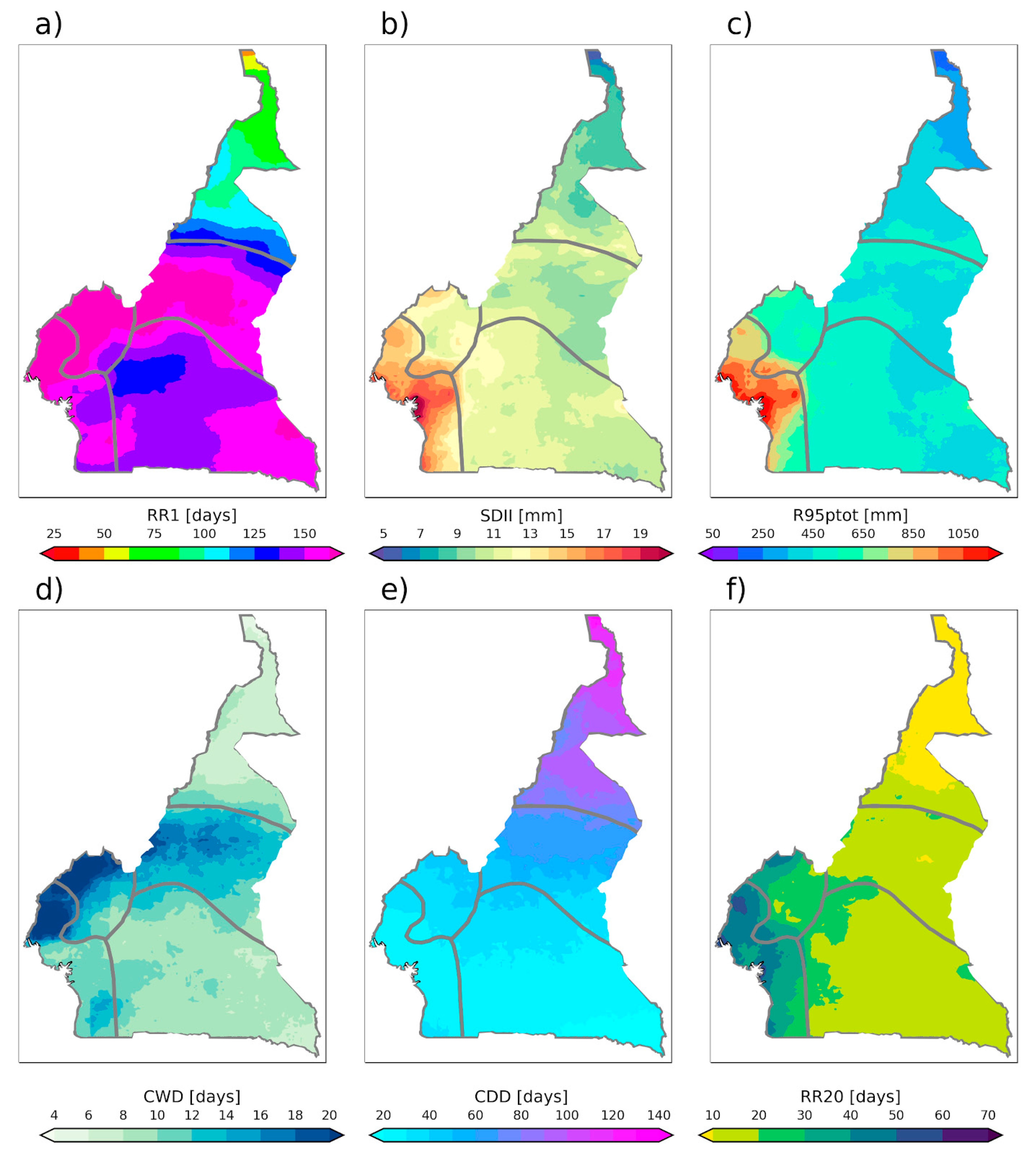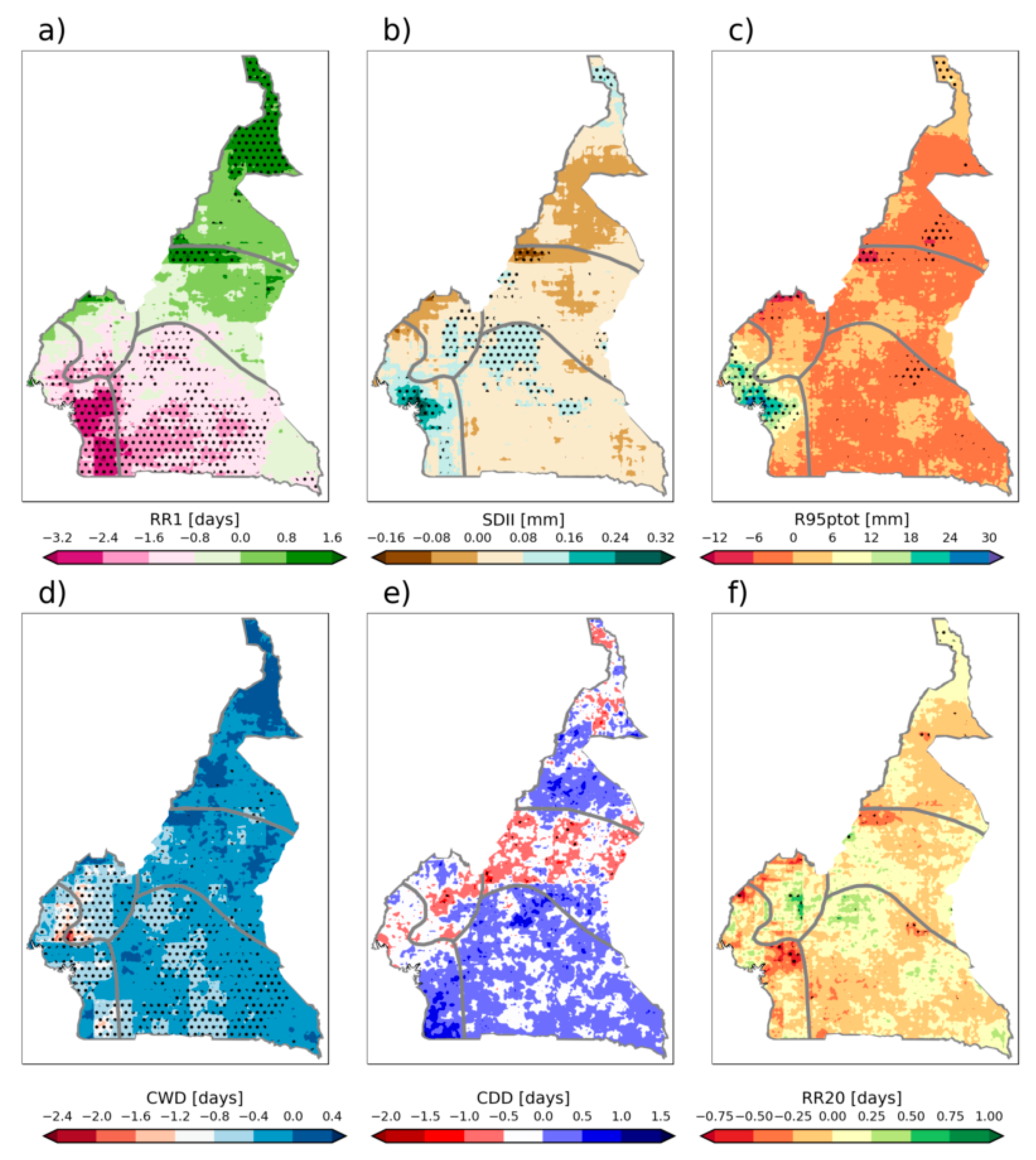Trends and Interannual Variability of Extreme Rainfall Indices over Cameroon
Abstract
1. Introduction
2. Data and Method
2.1. Study Area
2.2. Data Used
2.3. Methodology
3. Results and Discussion
3.1. Climatological Mean Annual Precipitation
3.2. Spatial Variability of Extreme Indices
3.3. Trend Study
3.4. SPI Time Series
4. Conclusions
Author Contributions
Funding
Institutional Review Board Statement
Informed Consent Statement
Data Availability Statement
Acknowledgments
Conflicts of Interest
References
- Nonki, R.M.; Lenouo, A.; Lennard, C.J.; Tchawoua, C. Assessing Climate Change Impacts on Water Resources in the Benue River Basin, Northern Cameroon. Environ. Earth Sci. 2019, 78. [Google Scholar] [CrossRef]
- Penlap, E.; Matulla, C.; von Storch, H.; Kamga, F. Downscaling of GCM Scenarios to Assess Precipitation Changes in the Little Rainy Season (March–June) in Cameroon. Clim. Res. 2004, 26, 85–96. [Google Scholar] [CrossRef]
- Tanessong, R.S.; Vondou, D.A.; Djomou, Z.Y.; Igri, P.M. WRF High Resolution Simulation of an Extreme Rainfall Event over Douala (Cameroon): A Case Study. Modeling Earth Syst. Environ. 2017, 3, 927–942. [Google Scholar] [CrossRef]
- Igri, P.M.; Tanessong, R.S.; Vondou, D.A.; Panda, J.; Garba, A.; Mkankam, F.K.; Kamga, A. Assessing the Performance of WRF Model in Predicting High-Impact Weather Conditions over Central and Western Africa: An Ensemble-Based Approach. Nat. Hazards 2018, 93, 1565–1587. [Google Scholar] [CrossRef]
- Guenang, G.M.; Mkankam Kamga, F. Onset, Retreat and Length of the Rainy Season over Cameroon. Atmos. Sci. Lett. 2012, 13, 120–127. [Google Scholar] [CrossRef]
- Vondou, D.A.; Haensler, A. Evaluation of Simulations with the Regional Climate Model REMO over Central Africa and the Effect of Increased Spatial Resolution. Int. J. Climatol. 2017, 37, 741–760. [Google Scholar] [CrossRef]
- Fotso-Nguemo, T.C.; Diallo, I.; Diakhaté, M.; Vondou, D.A.; Mbaye, M.L.; Haensler, A.; Gaye, A.T.; Tchawoua, C. Projected Changes in the Seasonal Cycle of Extreme Rainfall Events from CORDEX Simulations over Central Africa. Clim. Chang. 2019, 155, 339–357. [Google Scholar] [CrossRef]
- Mboka, J.M.; Kouna, S.B.; Chouto, S.; Djuidje, F.K.; Nguy, E.B.; Fotso-Kamga, G.; Matsaguim, C.N.; Fotso-Nguemo, T.C.; Nghonda, J.P.; Vondou, D.A.; et al. Simulated Impact of Global Warming on Extreme Rainfall Events over Cameroon during the 21st Century. Weather 2020. [Google Scholar] [CrossRef]
- Aguilar, E.; Aziz Barry, A.; Brunet, M.; Ekang, L.; Fernandes, A.; Massoukina, M.; Mbah, J.; Mhanda, A.; do Nascimento, D.J.; Peterson, T.C.; et al. Changes in Temperature and Precipitation Extremes in Western Central Africa, Guinea Conakry, and Zimbabwe, 1955–2006. J. Geophys. Res. 2009, 114, 1–11. [Google Scholar] [CrossRef]
- Molua, E. Climatic Trends in Cameroon: Implications for Agricultural Management. Clim. Res. 2006, 30, 255–262. [Google Scholar] [CrossRef]
- Funk, C.; Peterson, P.; Landsfeld, M.; Pedreros, D.; Verdin, J.; Shukla, S.; Husak, G.; Rowland, J.; Harrison, L.; Hoell, A.; et al. The Climate Hazards Infrared Precipitation with Stations—A New Environmental Record for Monitoring Extremes. Sci. Data 2015, 2, 1–21. [Google Scholar] [CrossRef]
- Funk, C.; Peterson, P.; Peterson, S.; Shukla, S.; Davenport, F.; Michaelsen, J.; Knapp, K.R.; Landsfeld, M.; Husak, G.; Harrison, L.; et al. A High-Resolution 1983–2016 Tmax Climate Data Record Based on Infrared Temperatures and Stations by the Climate Hazard Center. J. Clim. 2019, 32, 5639–5658. [Google Scholar] [CrossRef]
- Camberlin, P.; Barraud, G.; Bigot, S.; Dewitte, O.; Makanzu Imwangana, F.; Maki Mateso, J.; Martiny, N.; Monsieurs, E.; Moron, V.; Pellarin, T.; et al. Evaluation of Remotely Sensed Rainfall Products over Central Africa. Q. J. R. Meteorol. Soc. 2019, 145, 2115–2138. [Google Scholar] [CrossRef]
- Liebmann, B.; Bladé, I.; Funk, C.; Allured, D.; Quan, X.-W.; Hoerling, M.; Hoell, A.; Peterson, P.; Thiaw, W.M. Climatology and Interannual Variability of Boreal Spring Wet Season Precipitation in the Eastern Horn of Africa and Implications for Its Recent Decline. J. Clim. 2017, 30, 3867–3886. [Google Scholar] [CrossRef]
- Bichet, A.; Diedhiou, A. Less Frequent and More Intense Rainfall along the Coast of the Gulf of Guinea in West and Central Africa (1981–2014). Clim. Res. 2018, 76, 191–201. [Google Scholar] [CrossRef]
- Kpanou, M.; Laux, P.; Brou, T.; Vissin, E.; Camberlin, P.; Roucou, P. Spatial Patterns and Trends of Extreme Rainfall over the Southern Coastal Belt of West Africa. Theor. Appl. Climatol. 2020, 143, 473–487. [Google Scholar] [CrossRef]
- Toté, C.; Patricio, D.; Boogaard, H.; van der Wijngaart, R.; Tarnavsky, E.; Funk, C. Evaluation of Satellite Rainfall Estimates for Drought and Flood Monitoring in Mozambique. Remote Sens. 2015, 7, 1758–1776. [Google Scholar] [CrossRef]
- Dinku, T.; Funk, C.; Peterson, P.; Maidment, R.; Tadesse, T.; Gadain, H.; Ceccato, P. Validation of the CHIRPS Satellite Rainfall Estimates over Eastern Africa. Q. J. R. Meteorol. Soc. 2018, 144, 292–312. [Google Scholar] [CrossRef]
- Zhang, X.; Alexander, L.; Hegerl, G.C.; Jones, P.; Tank, A.K.; Peterson, T.C.; Trewin, B.; Zwiers, F.W. Indices for Monitoring Changes in Extremes Based on Daily Temperature and Precipitation Data. WIREs Clim. Chang. 2011, 2, 851–870. [Google Scholar] [CrossRef]
- Guenang, G.M.; Kamga, F.M. Computation of the Standardized Precipitation Index (SPI) and Its Use to Assess Drought Occurrences in Cameroon over Recent Decades. J. Appl. Meteorol. Climatol. 2014, 53, 2310–2324. [Google Scholar] [CrossRef]
- Guenang, G.M.; Komkoua, M.A.J.; Pokam, M.W.; Tanessong, R.S.; Tchakoutio, S.A.; Vondou, A.; Tamoffo, A.T.; Djiotang, L.; Yepdo, Z.; Mkankam, K.F. Sensitivity of SPI to Distribution Functions and Correlation Between Its Values at Different Time Scales in Central Africa. Earth Syst. Environ. 2019, 3, 203–214. [Google Scholar] [CrossRef]
- Musonda, B.; Jing, Y.; Iyakaremye, V.; Ojara, M. Analysis of Long-Term Variations of Drought Characteristics Using Standardized Precipitation Index over Zambia. Atmosphere 2020, 11, 1268. [Google Scholar] [CrossRef]
- Sen, P.K. Estimates of the Regression Coefficient Based on Kendall’s Tau. J. Am. Stat. Assoc. 1968, 63, 1379–1389. [Google Scholar] [CrossRef]
- Nicholson, S.E.; Fink, A.H.; Funk, C. Assessing Recovery and Change in West Africa’s Rainfall Regime from a 161-Year Record. Int. J. Climatol. 2018, 38, 3770–3786. [Google Scholar] [CrossRef]
- Biasutti, M. Rainfall Trends in the African Sahel: Characteristics, Processes, and Causes. WIREs Clim. Chang. 2019, 10, e591. [Google Scholar] [CrossRef]
- Njouenwet, I.; Vondou, D.A.; Fita Dassou, E.; Ayugi, B.O.; Nouayou, R. Assessment of Agricultural Drought during Crop-Growing Season in the Sudano–Sahelian Region of Cameroon. Nat. Hazards 2021, 106, 561–577. [Google Scholar] [CrossRef]
- Ajayi, V.O.; Ilori, O.W. Projected Drought Events over West Africa Using RCA4 Regional Climate Model. Earth Syst. Environ. 2020, 4, 329–348. [Google Scholar] [CrossRef]





| Agro-Ecological Region | Min | Max | Mean | STD | CV (%) |
|---|---|---|---|---|---|
| ZFM | 2094.8 | 2808.2 | 2458.6 | 159.1 | 5.72 |
| ZFB | 1427.8 | 1856.4 | 1640.1 | 86.4 | 5.27 |
| ZHP | 1973.3 | 2536.3 | 2239.1 | 120.6 | 5.38 |
| ZHS | 1339.7 | 1712.2 | 1604.0 | 84.1 | 5.23 |
| ZSS | 650.7 | 1083.7 | 885.8 | 92.7 | 10.47 |
| Agro-Ecological Region | p-Value | Z | Slope | Tau |
|---|---|---|---|---|
| ZFM | 0.25 | −1.13 | −0.128 | −2.527 |
| ZFB | 0.16 | −1.37 | −0.155 | −1.786 |
| ZHP | 0.96 | −0.04 | −0.006 | −0.066 |
| ZHS | 0.41 | 0.82 | 0.093 | 1.002 |
| ZSS | 0.09 | 1.64 | 0.184 | 2.461 |
Publisher’s Note: MDPI stays neutral with regard to jurisdictional claims in published maps and institutional affiliations. |
© 2021 by the authors. Licensee MDPI, Basel, Switzerland. This article is an open access article distributed under the terms and conditions of the Creative Commons Attribution (CC BY) license (https://creativecommons.org/licenses/by/4.0/).
Share and Cite
Vondou, D.A.; Guenang, G.M.; Djiotang, T.L.A.; Kamsu-Tamo, P.H. Trends and Interannual Variability of Extreme Rainfall Indices over Cameroon. Sustainability 2021, 13, 6803. https://doi.org/10.3390/su13126803
Vondou DA, Guenang GM, Djiotang TLA, Kamsu-Tamo PH. Trends and Interannual Variability of Extreme Rainfall Indices over Cameroon. Sustainability. 2021; 13(12):6803. https://doi.org/10.3390/su13126803
Chicago/Turabian StyleVondou, Derbetini A., Guy Merlin Guenang, Tchotchou Lucie Angennes Djiotang, and Pierre Honore Kamsu-Tamo. 2021. "Trends and Interannual Variability of Extreme Rainfall Indices over Cameroon" Sustainability 13, no. 12: 6803. https://doi.org/10.3390/su13126803
APA StyleVondou, D. A., Guenang, G. M., Djiotang, T. L. A., & Kamsu-Tamo, P. H. (2021). Trends and Interannual Variability of Extreme Rainfall Indices over Cameroon. Sustainability, 13(12), 6803. https://doi.org/10.3390/su13126803






